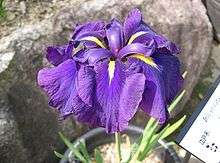Japanese iris
The term "Japanese iris" encompasses three species of Irises cultivated in gardens or growing wild in Japan: hanashōbu (Iris ensata), kakitsubata (Iris laevigata) and ayame (Iris sanguinea). Of these three species, I. ensata is the one most commonly referred to as "Japanese iris" outside Japan.
The bluish purple color of the flowers of the Japanese garden iris is an example of the copigmentation phenomenon.[1]


Hanashōbu
The Hanashōbu (ハナショウブ, 花菖蒲, Iris ensata var. ensata, syn. I. ensata var. hortensis I. kaempferi) grows in the wet land and is the most extensively cultivated variety in Japanese gardens. According to the place where it was cultivated, it is classified into the Edo (Tokyo), Higo (Kumamoto Prefecture), Ise (Mie Prefecture), American (U.S.A.) and other series. It is extensively grown in gardens throughout the temperate zones. Several cultivars have been selected, of which 'Rose Queen'[2] and 'Variegata'[3] have gained the Royal Horticultural Society's Award of Garden Merit.
Kakitsubata
The Kakitsubata (link to article in Japanese) (カキツバタ, 杜若, Iris laevigata) grows in the semi-wet land and is less popular, but is also cultivated extensively.
It is a prefectural flower of Aichi Prefecture due to the famous tanka poem which is said to have been written in this area during the Heian period, as it appears in The Tales of Ise by Ariwara no Narihira (note that the beginning syllables are "ka-ki-tsu-ha (ba)-ta"):
| Original text | Pronunciation | Meaning |
|---|---|---|
|
から衣 きつゝなれにし つましあれば はるばるきぬる たびをしぞ思 |
Karakoromo Kitsutsu narenishi Tsuma shi areba, Harubaru kinuru Tabi o shizo omou |
I have come so far away on this trip this time and think of my wife that I left in Kyoto |
Kakitsubata at Ōta Shrine, Kyoto, is a National Natural Treasure. It was already recorded in a tanka by Fujiwara Toshinari also in the Heian period:
| Original text | Pronunciation | Meaning |
|---|---|---|
|
神山や大田の沢のかきつばた ふかきたのみは色に見ゆらむ |
Kamiyama ya ōta no sawa no kakitsubata Fukaki tanomi wa iro ni miyu ramu |
Like the kakitsubata at Ōta Wetland, a God-sent heaven, my trust in you can be seen in the color of their flowers. |
Ayame
The Ayame (アヤメ, 菖蒲, 文目, Iris sanguinea) is the iris typically growing wild on the dry land in Japan.
Characteristics
| Classification | Color of flower | Leaf | Feature of flower | Location | Flowering time |
|---|---|---|---|---|---|
| Hanashōbu | Red purple, purple, etc. | Distinct artery | Shows no net | Wet land | Early June - late June |
| Kakitsubata | Blue, purple, white, etc. | Small artery | Shows no net | In water or wet land | mid-May - late May |
| Ayame | Purple, rarely white | Main artery not clear | Shows net | Dry land | Early May - Mid-June |
Note: Sweet flag, called Shōbu (ショウブ, 菖蒲) in Japanese, is a plant belonging to the family Acoraceae, genus Acorus, known for its fragrant roots, rather than its flowers.
See also
References
- ↑ Anthocyanin-flavone copigmentation in bluish purple flowers of Japanese garden iris (Iris ensata Thunb.) T. Yabuya, M. Nakamura, T. Iwashina, M. Yamaguchi and T. Takehara, EUPHYTICA, Volume 98, Number 3, 163-167, doi:10.1023/A:1003152813333
- ↑ "RHS Plant Selector - Iris ensata 'Rose Queen'". Royal Horticultural Society. Retrieved 2013-05-20.
- ↑ "RHS Plant Selector - Iris ensata 'Variegata'". Royal Horticultural Society. Retrieved 2013-05-20.
External links
- Japanese Iris/Hanashobu Wall Paper Files (in Japanese)
- Japanese Iris/Hanashobu Photo Album 1 (in Japanese)
- Japanese Iris/Hanashobu Photo Album 2 (in Japanese)